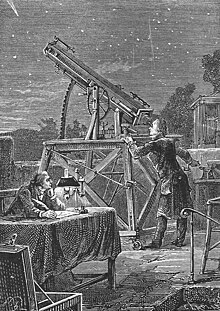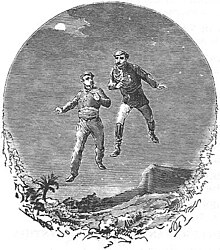Journey through the solar world

Journey through the solar world (also Hektor Servadac's journey through the solar world , Hektor Servadac's space journey , or journey through the solar system ) is a novel by the French author Jules Verne . The novel was first published in 1877 by the publisher Pierre-Jules Hetzel in two volumes under the French title Hector Servadac . Volume I appeared on July 19, 1877 and Volume II on November 7, 1877. The first German-language edition appeared in 1878 under the title Reise durch die Sonnenwelt .
action
The captain of the French army in Algeria, Hector Servadac, argues with the Russian Count Wassili Timascheff , who is anchored off the coast with his schooner Dobryna , about the favor of a young widow. They arrange to meet for a duel the next morning. Both are located at the end of a small cape between Tenez and Mostaganem , about 3 km from the mouth of the Cheliff . Servadac passes the waiting time by writing a rondeau to the beloved and talking to his orderly officer Ben-Zouf. Ben-Zouf, whose real name is Laurent, comes from Paris from Montmartre .
In the evening, while walking along the coast, Servadac notices a strange reddish light through the haze of the earth's atmosphere . While he was working on his poem later, he and Ben-Zouf were thrown to the ground by a tremendous force. Then the horizon changed, gigantic waves piling up and an unusual glow can be seen in the sky. The moon seems to have multiplied in size. Discover Servadac and Ben-Zouf that the sun suddenly rises from the west, the Cheliff has disappeared, the gravity of the earth has decreased and one day the length has been reduced to six hours. Algeria now seems to be on the equator as the sun is almost vertical at noon.
They realize that they are alone on an island they call Gourbi. The air pressure has decreased noticeably. The earth's axis no longer points to the Pole Star , but to Vega in the constellation Lyra . The temperature rises rapidly within two weeks. The earth seems to be approaching the sun. They are moving in the direction of Venus and Mercury . They fear a collision of the earth with Venus, but the distance to Venus increases again later. Ben-Zouf spots a ship that turns out to be the Dobryna . Count Timascheff and the crew also do not know what catastrophe occurred.
The Graf and Servadac plan to sail the Mediterranean to find out what happened. Apart from the island of Gourbi, you won't find any other land at first. The evenly flat sea floor consists of a golden metal dust. You will find a rock in the sea on which only the grave of St. Ludwig is located. They then come across a 70 to 100 meter high, infinitely elongated cliff, along which they drive for several days. Part of the British garrison in Gibraltar also survived the disaster. However, the soldiers do not want to give up their base.
A leather telescope case floats in the sea, in which they find a message. The sender writes about a Gallia and describes its path through the solar system. They have now left the orbit of Mars behind and are approaching Jupiter and Saturn . Also of Uranus is now visible to the naked eye. The air temperature continues to decrease. However, they do not know how far the aphelion of their orbit is from the Sun. There is nothing left of the French coast. Where Corsica was previously , you will only find the small island of Magdalena, on which eight-year-old Nina is with a goat.
When you return to Gourbi, you will find Ben-Zouf, a few Spaniards and a Jewish merchant who comes from Germany. Isaac Hakhabut had set out from Cologne with his Tartane Hansa to trade in the Mediterranean. On the way he had picked up the Spaniards. Meanwhile the temperature continues to decrease due to the increasing distance from the sun. They decide to move to an island where they have spotted an active volcano and intend to use it as a heat source. They settle with their colony in a cave on the volcanic island . Gallia has in the meantime got the moon Nerina. Presumably the object is a captured asteroid .
The Dobryna and the Hansa freeze in the ice in front of the volcanic island. Through a message from a pigeon is brought to the volcanic island, learn the travelers that the mysterious sender on the Balearic -Insel Formentera is and threatens to starve. With a dinghy converted into a sailing sleigh, they reach the sender, who turns out to be Servadac's former physics teacher Palmyrin Rosette.
He explains to them that they are on a comet that has taken some earthly rocks with it when it collided with the earth. Before the catastrophe, Rosette had observed the comet for several nights and calculated that its orbit would cross the ecliptic and that the comet would collide with the earth. Gallia's orbit around the sun is an ellipse that brings the comet back to an encounter with the earth after two years. Rosette calculates the dimensions and mass of Gallia with the help of a scale , but later has to correct his calculations because Hakhabut turned him on a manipulated scale. In his opinion, Gallia is 70% tellurium and 30% gold .
Meanwhile Gallia passes Jupiter. The travelers see the four Galilean moons Europa , Io , Ganymede and Callisto with their bare eyes. Then they pass the orbit of Saturn. Rosette observes eight of Saturn's moons and Saturn's rings . The two ships are lifted up more and more by the pack ice . Meanwhile, the volcano gradually ceases its activity, the lava seems to have found another drain into the interior of the comet.
The colony has to move deeper into the volcanic crater as the temperature in the previous accommodation is decreasing more and more. As Gallia deeper back into the interior of the solar system penetrates want Servadac and Ben-Zouf on a remnant of Ceuta the flag of France hoist, but found there already a detachment of British soldiers of Gibraltar before. They inform the British that they are on a comet and propose to them to move to them in order to prepare together for the new collision of Gallia with Earth calculated by Rosette. However, the British reject this. Gallia loses the moon Nerina again, which for unknown reasons says goodbye to the depths of space.
The Russian Lieutenant Prokop has the idea that the colonists can use a hot air balloon to leave the surface of Gallia before it hits the earth. The warming sea melts the ice floes piling up around the island . The two ships fall with ice masses and are destroyed in the process. An explosion tears off part of Gallia, where Gibraltar, Ceuta and the British soldiers are located. Before the collision of Gallia with the earth, the colonists take off with the balloon made from the sails of the Dobryna and find themselves after the collision near the city of Mostaganem. Nobody on earth noticed the comet. The former colonists are greeted with amazement, nobody believes their story of the journey through the solar world.
Figure drawing
When describing the figure of the German Jew Hakhabut, Verne resorted to numerous anti-Jewish clichés, for example when he describes his appearance (“ ... with false eyes, curved nose, yellowish-red beard, shaggy hair, large feet, long, claw-like hands , ... "/" Usurer with the humpback ") and subordinated to him unscrupulous profit and advantage striving (" Although Israelite by birth, he played the Mohammedan in the Muslim countries and would have become a pagan if that had thrown him off "). After the appearance of this story, Verne's publisher Hetzel received a letter from the Parisian rabbi Zadoc Kahn , in which he criticized this characterization as "hurting all Jews".
Film adaptations
- Valley of the Dragons (1961) a Columbia Pictures film directed by Edward Bernds
- Na kometě (On the Comet) (1970), by Czech director Karel Zeman
literature
- Heinrich Pleticha (ed.): Jules Verne manual . Deutscher Bücherbund / Bertelsmann, Stuttgart and Munich 1992.
- Volker Dehs and Ralf Junkerjürgen: Jules Verne . Voices and interpretations of his work. Fantastic Library Wetzlar, Wetzlar 2005.
- Volker Dehs: Jules Verne . Jules Verne. A critical biography. Artemis & Winkler, Düsseldorf 2005. ISBN 3-538-07208-6
Web links
- Journey Thru Planetary Space as an add-on for the astronomy program Celestia and as HTML - e-book in English and French
- "Journey through the world of the sun" as an e-book in HTML on zeno.org
- Journey through the solar system in Andreas Fehrmann's Jules Verne Collection

